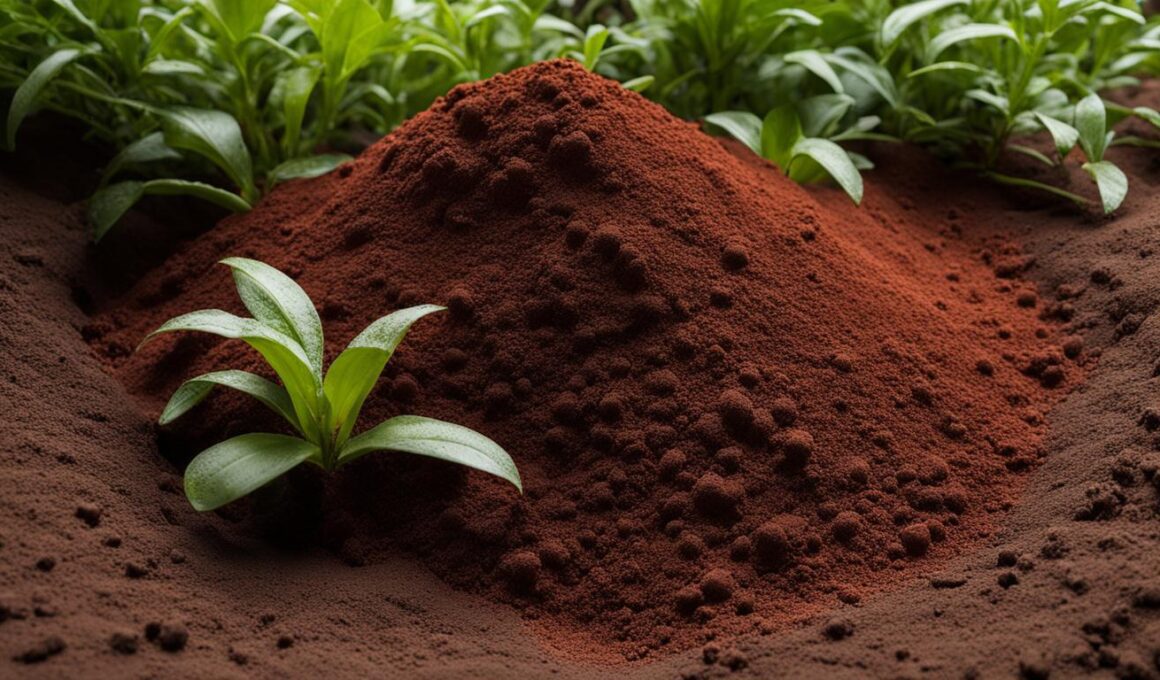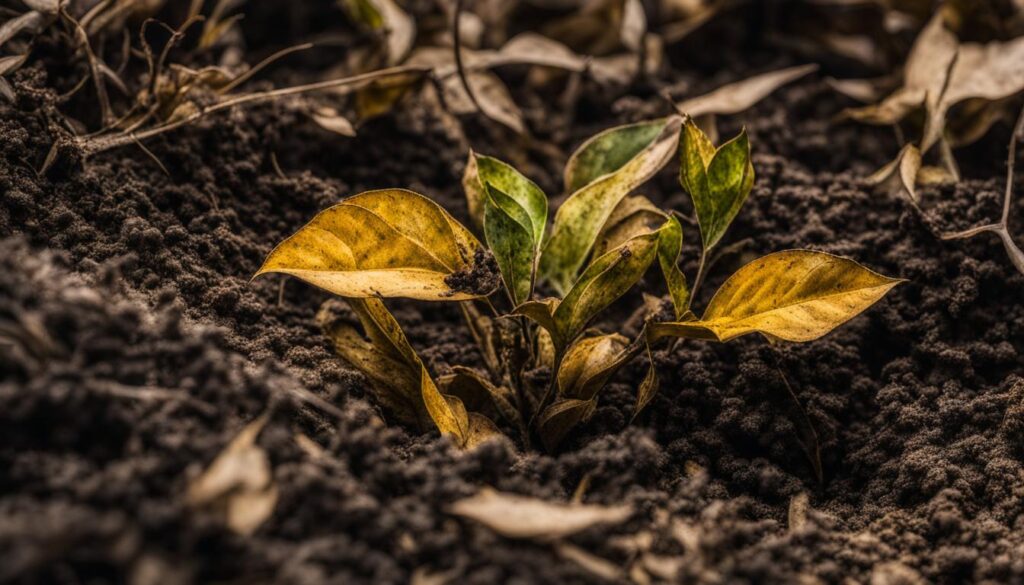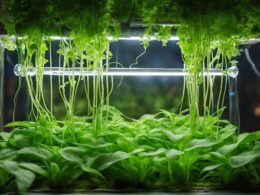Lowering manganese levels in soil is crucial for maintaining optimal plant growth and preventing both deficiency and toxicity. Manganese deficiency can lead to reduced crop yields and poor quality produce, while excessive levels of manganese can cause damage to photosynthesis and enzyme activity. Understanding the causes and solutions to these issues is essential for effective soil management.
Post Summary
- Manganese deficiency can result in reduced crop yields and impaired photosynthesis.
- Manganese toxicity can cause damage to photosynthesis and enzyme activity.
- Testing soil pH and adjusting lime applications can help prevent or correct manganese problems.
- Foliar applications of manganese fertilizer are recommended for calcareous soils.
- Applying lime to raise pH levels and improving soil drainage can help mitigate manganese toxicity.
Understanding Manganese Deficiency
Manganese deficiency in soil can have a significant impact on crop yield and overall plant health. This micronutrient plays a crucial role in various biological processes, including photosynthesis and starch synthesis. When plants lack sufficient manganese, they develop symptoms such as interveinal chlorosis in younger leaves and necrotic spots. These visual indications are a result of impaired chlorophyll production and reduced enzyme activity.
Manganese deficiency is more common in calcareous soils with high pH levels or those with high organic matter content. Additionally, poor soil aeration can contribute to this deficiency. It’s important to note that excess iron can also lead to manganese deficiency, as these two elements compete for uptake by plants.
To diagnose and address manganese deficiency, foliar applications of manganese fertilizer or traditional soil tests can be employed. These methods help determine the severity of the deficiency and provide insights into the appropriate treatment approach.
The table below summarizes the symptoms and causes of manganese deficiency:
| Symptoms | Causes |
|---|---|
| Interveinal chlorosis in younger leaves | Calcareous soils |
| Necrotic spots | High pH levels |
| Reduced chlorophyll production | High organic matter content |
| Impaired enzyme activity | Poor soil aeration |
Treating Manganese Deficiency
When dealing with manganese deficiency in calcareous soils, foliar applications of manganese fertilizer are recommended. This approach ensures direct uptake by plants, bypassing any soil limitations. To effectively address manganese deficiency, it is also important to incorporate organic matter into the soil. This can be done through the application of compost or other organic amendments, which enhance nutrient availability and improve soil structure. Additionally, adjusting soil pH through lime applications can help prevent or correct deficiencies in calcareous soils.
Table: Recommended Treatments for Manganese Deficiency in Calcareous Soils
| Treatment | Description |
|---|---|
| Foliar Application of Manganese Fertilizer | Directly applies manganese to the plant leaves, ensuring efficient uptake. |
| Incorporation of Organic Matter | Adds organic amendments to improve nutrient availability and soil structure. |
| Adjustment of Soil pH | Targets calcareous soils by applying lime to raise pH levels and mitigate deficiencies. |
Manganese deficiency is less likely in typical mineral soils but can still occur in fields with varying organic matter content. In such cases, adjusting limestone rates based on soil variations can be beneficial. It is important to note that implementing these treatments should be done in conjunction with regular soil testing and analysis of tissue samples to ensure accurate diagnosis and precise adjustments to nutrient management plans.
Understanding Manganese Toxicity
Manganese toxicity can have detrimental effects on plants, impacting photosynthesis, enzyme activity, and overall plant health. Understanding the symptoms and contributing factors is crucial in effectively managing this issue.
One of the primary symptoms of manganese toxicity is the development of brown spots on mature leaves. These spots can spread and eventually lead to necrosis. Additionally, chlorotic specks may appear on young leaves. Older leaves tend to be more affected by manganese toxicity.
Factors that contribute to manganese toxicity include acidic soils with low calcium levels and poor soil drainage. Excessive irrigation, soil compaction, and high precipitation can lead to oxygen deficiency, further exacerbating the problem. Monitoring soil pH, calcium levels, and ensuring proper soil drainage are essential in preventing and managing manganese toxicity.
It is important to note that the threshold for manganese toxicity varies among plant species. Some plants may be more tolerant to elevated levels of manganese, while others are more sensitive. Therefore, it is essential to consider the specific requirements of the plants being cultivated and tailor management strategies accordingly.
Treating Manganese Toxicity
To address manganese toxicity in soil, there are several effective treatments that can help restore a balanced soil environment and mitigate the negative effects. One of the key strategies is the application of lime to raise pH levels, especially in acidic soils. By increasing the pH, the availability of manganese to plants is reduced, helping to alleviate toxicity. Incorporating magnesium through fertilizers or organic matter can also prove beneficial, as magnesium can compete with manganese for uptake by plants.
Proper soil moisture management is another crucial aspect when treating manganese toxicity. Consistent soil moisture levels should be maintained to prevent the accumulation of toxic levels of manganese. It is important to ensure adequate soil drainage to avoid waterlogging, which can exacerbate manganese toxicity. Improving soil drainage can be achieved through measures such as installing appropriate drainage systems or implementing soil amendment practices.
In cases where manganese toxicity is severe, it may be necessary to implement a combination of these treatments and closely monitor the response of plants. Regular soil testing and plant tissue analysis can provide valuable insights into the effectiveness of the treatments and help adjust the approach if needed. By following these recommended treatments and monitoring techniques, it is possible to effectively manage manganese toxicity and promote healthier plant growth.
Benefits of Treating Manganese Toxicity:
- Restores a balanced soil environment
- Alleviates the negative effects of manganese toxicity
- Reduces the availability of toxic levels of manganese to plants
- Prevents further damage to photosynthesis and enzyme activity
- Promotes healthier plant growth and productivity
| Treatment | Description |
|---|---|
| Lime Application | Raises pH levels in acidic soils, reducing manganese availability |
| Magnesium Incorporation | Competes with manganese for uptake by plants, reducing toxicity |
| Soil Moisture Management | Maintains consistent soil moisture levels to prevent manganese accumulation |
| Improving Soil Drainage | Enhances soil drainage to avoid waterlogging and exacerbation of manganese toxicity |
By implementing these treatments and management strategies, farmers and gardeners can effectively address manganese toxicity in their soils and promote the optimal growth and development of their plants.
Common Manganese Fertilizers and Their Composition
When it comes to managing manganese levels in soil, choosing the right fertilizer is essential. There are several common manganese fertilizers available, each with its own composition and benefits. Understanding the differences can help you make an informed decision for your specific soil needs.
Manganese Sulfate
Manganese sulfate is a highly soluble form of manganese fertilizer, containing approximately 26-28% manganese. It is a popular choice for addressing manganese deficiencies in the soil. Its high solubility ensures better availability for plant uptake, especially in sandy, leachable soils. Manganese sulfate is typically distributed evenly across the soil surface through broadcasting.
Manganese Oxide
Manganese oxide is another common manganese fertilizer with a composition of 41-68% manganese. This form of manganese is suitable for acidic soils due to its low solubility, ensuring a slow release of manganese over time. It is often used to address manganese deficiencies in calcareous soils, where higher solubility forms may not be as effective.
Manganese EDTA
Manganese EDTA is a chelated form of manganese fertilizer, containing approximately 12-13% manganese. This chelated form provides better stability and nutrient availability in the soil. It is often used in situations where rapid uptake and correction of manganese deficiencies are required.
Manganese Chloride
Manganese chloride is another option for manganese fertilizer formulations. It provides a readily available source of manganese for plants. However, it is important to use manganese chloride cautiously, as it can be toxic to plants if used in excess.
| Fertilizer | Composition | Benefits |
|---|---|---|
| Manganese Sulfate | Approximately 26-28% manganese | High solubility, better availability, suitable for sandy soils |
| Manganese Oxide | Composition of 41-68% manganese | Low solubility, slow release, suitable for acidic soils |
| Manganese EDTA | Approximately 12-13% manganese | Chelated form, better stability, rapid uptake |
| Manganese Chloride | Variable composition | Readily available, use with caution |
Choosing the right manganese fertilizer for your soil will depend on various factors, including soil type, pH levels, and specific nutrient requirements. It is recommended to conduct soil tests and consult with agricultural experts to determine the most suitable fertilizer for your needs.
Essential Role of Manganese in Plants
Manganese is a crucial micronutrient that plays an essential role in the growth and development of plants. Its presence is vital for various biological processes, ensuring optimal plant health and productivity. Let’s explore some key functions that manganese serves in plants:
1. Photosynthesis:
Manganese is an integral component of the photosynthetic process. It facilitates the conversion of light energy into chemical energy, enabling plants to synthesize nutrients. Without sufficient manganese, photosynthesis is impaired, leading to reduced plant growth and productivity.
2. Chlorophyll Production:
Chlorophyll, the pigment responsible for the green color in plants, relies on manganese for its synthesis. Manganese activates enzymes involved in chlorophyll production, ensuring the efficient absorption of light energy for photosynthesis.
3. Enzyme Activation:
Manganese plays a vital role in activating various enzymes responsible for essential plant processes. It is involved in nitrate reduction, carbohydrate metabolism, starch production, cell division, and elongation. These enzymatic activities are crucial for plant growth and development.
4. Fatty Acid Biosynthesis:
Manganese is also involved in the biosynthesis of fatty acids, which are essential components of plant cell membranes. Adequate manganese levels ensure proper cell membrane function, maintaining structural integrity and facilitating nutrient absorption.
As you can see, manganese is a micronutrient that plants cannot thrive without. Its involvement in photosynthesis, chlorophyll production, enzyme activation, and fatty acid biosynthesis highlights its essential role in plant metabolism. By ensuring an adequate supply of manganese, you can support optimal plant growth and productivity.
Manganese Deficiency Symptoms and Causes
Manganese deficiency in soil can have detrimental effects on crop yield and overall plant health. The deficiency primarily manifests in younger leaves, resulting in reduced photosynthesis and impaired growth. It is crucial to identify and address manganese deficiency to ensure optimal plant nutrition and productivity.
The visual symptoms of manganese deficiency include interveinal chlorosis, where the tissue between the leaf veins turns yellow while the veins remain green. This chlorotic appearance is most noticeable in younger leaves, as manganese is not easily remobilized within the plant. Tissue levels of manganese below 20 to 40 ppm indicate deficiency, necessitating corrective measures.
Several factors contribute to manganese deficiency in soil. Calcareous soils, characterized by high pH levels and a high content of organic matter, are more prone to manganese deficiency. Poor soil aeration and drainage can also limit manganese availability. Regular soil testing and monitoring are essential to identify and manage manganese deficiency in these conditions.
Manganese Deficiency Symptoms:
- Interveinal chlorosis in younger leaves
- Reduced photosynthesis
- Impaired growth and development
Possible Causes of Manganese Deficiency:
- Calcareous soils with high pH levels
- High organic matter content in soil
- Inadequate soil aeration and drainage
Addressing manganese deficiency involves implementing appropriate soil amendments and nutrient management strategies. Applying manganese fertilizers, such as manganese sulfate, can help replenish deficient levels in the soil. Additionally, adjusting soil pH and improving soil aeration through proper tillage practices can enhance manganese availability for plant uptake. Regular monitoring and proactive measures are key to preventing and correcting manganese deficiency in crop production systems.
| Manganese Deficiency Symptoms | Possible Causes |
|---|---|
| Interveinal chlorosis in younger leaves | Calcareous soils with high pH levels |
| Reduced photosynthesis | High organic matter content in soil |
| Impaired growth and development | Inadequate soil aeration and drainage |
Manganese Toxicity Symptoms and Contributing Factors
Manganese toxicity can have detrimental effects on plant health, particularly on older leaves. It is important to recognize the symptoms and understand the contributing factors to effectively manage this issue. Symptoms of manganese toxicity include the appearance of brown spots on mature leaves and chlorotic specks on young leaves. Although the precise threshold for toxicity varies among plant species, it is generally characterized by visual damage to leaf tissue.
Several factors contribute to manganese toxicity in soil. Firstly, soil pH below 5.5 can increase the availability of manganese, leading to higher uptake by plants. Low calcium levels in the soil also contribute to manganese toxicity. Inadequate oxygen availability due to excessive irrigation, poor soil drainage, soil compaction, or high precipitation exacerbates the problem by promoting the release of toxic levels of manganese.
To manage manganese toxicity effectively, it is crucial to address the underlying factors. Raising the pH of acidic soils through lime application can help mitigate the effects of manganese toxicity. Ensuring adequate calcium levels in the soil and improving soil drainage are also important steps in reducing manganese toxicity. By identifying the symptoms and implementing appropriate measures, you can effectively manage manganese toxicity and promote optimal plant growth.
Summary:
Manganese toxicity in plants can cause damage to older leaves, with symptoms including brown spots on mature leaves and chlorotic specks on young leaves. Factors contributing to manganese toxicity include low soil pH, low calcium levels, and insufficient oxygen availability. Managing manganese toxicity involves raising soil pH, ensuring adequate calcium levels, and improving soil drainage. By addressing these factors, you can effectively manage manganese toxicity and support healthy plant growth.
Manganese in Soil: Availability and Interactions
The availability of manganese in soil is influenced by various soil reactions, including pH, redox conditions, soil moisture, temperature, and organic matter content. These factors play a crucial role in determining the availability of manganese to plants and ultimately impact plant growth and productivity.
Soil pH is a key factor affecting manganese availability. Manganese is more soluble at lower soil pH levels, typically below 5.5. As pH increases, the availability of manganese decreases. Therefore, maintaining a suitable pH range is essential for optimal manganese uptake by plants. It is recommended to adjust soil pH using appropriate amendments, such as lime or sulfur, based on soil testing results.
“Maintaining a suitable soil pH is crucial for ensuring adequate manganese availability to plants.”
Redox conditions in soil also influence manganese availability. Dry soil conditions and well-oxygenated soils tend to decrease manganese availability. In contrast, waterlogged or poorly drained soils create reduced (anaerobic) conditions, enhancing the availability of manganese due to redox reactions. It is important to maintain proper soil moisture levels and ensure adequate drainage to prevent excess manganese accumulation or deficiency.
The presence of organic matter in the soil affects manganese availability as well. Organic matter acts as a reservoir of manganese, releasing it slowly over time. Therefore, soils with higher organic matter content generally have greater manganese availability. It is advisable to incorporate organic matter, such as compost or well-rotted manure, into the soil to enhance manganese availability for plants.
Factors Affecting Manganese Availability in Soil
| Soil Reactions | Impact on Manganese Availability |
|---|---|
| Soil pH | Manganese is more soluble at lower pH levels, but availability decreases at higher pH levels. |
| Redox Conditions | Dry soil conditions decrease manganese availability, while waterlogged soils enhance it due to redox reactions. |
| Soil Moisture | Proper soil moisture levels are crucial for maintaining optimal manganese availability. |
| Organic Matter | Soils with higher organic matter content generally have greater manganese availability. |
Temperature fluctuations and microbial activity can also affect manganese availability, though their influence is generally more indirect. Colder temperatures may slow microbial activity, reducing manganese availability. Conversely, warmer temperatures can enhance microbial activity and the release of available manganese. It is important to consider these factors in conjunction with other soil conditions to effectively manage manganese levels in soil.
Understanding the availability and interactions of manganese in soil is crucial for optimizing plant growth and ensuring proper crop health. By assessing and managing soil reactions, such as pH, redox conditions, soil moisture, temperature, and organic matter content, farmers and gardeners can create a favorable environment for manganese uptake by plants, leading to improved yields and overall productivity.
Conclusion
To effectively manage manganese levels in soil and prevent both deficiency and toxicity, it is crucial to understand the causes, symptoms, and appropriate management strategies. Regular soil tests are essential for monitoring manganese levels and identifying any deficiencies or toxicities. Scouting for visual symptoms in crops can also help in early detection and prompt action.
Adjusting fertilization practices based on soil conditions is key to ensuring balanced manganese levels. For sandy soils, broadcasting manganese fertilizer and using the sulfate form is recommended for better availability. In heavier soils, foliar applications are more efficient in facilitating uptake by plants. Additionally, testing soil pH and adjusting lime applications can help prevent or correct manganese problems.
By implementing these management strategies and closely monitoring manganese levels, you can optimize plant growth and productivity. Remember, maintaining a balanced soil environment is crucial for the overall health and success of your crops.
Will Using Bt Affect the Manganese Levels in the Soil for Organic Gardening?
When considering bt safety in organic gardening, it’s important to understand its impact on soil health. Using Bt generally does not affect manganese levels in the soil. Bt, as a naturally occurring bacterium, works to control pests and can be used effectively in organic gardening practices without major disruptions to soil mineral levels.
FAQ
How can I lower manganese levels in soil?
To effectively lower manganese levels in soil, you can broadcast manganese fertilizer on sandy, leachable soils or use the sulfate form for better availability. For heavier soils, foliar applications are more efficient in ensuring uptake by plants. Additionally, testing soil pH and adjusting lime applications can help prevent or correct manganese problems. It is crucial to scout crops for visual symptoms and conduct tissue testing to confirm manganese deficiency before implementing appropriate solutions.
What are the symptoms and causes of manganese deficiency in soil?
Manganese deficiency in soil can lead to reduced crop yields and poor quality produce. This deficiency primarily affects the photosynthesis process and synthesis of starch, resulting in interveinal chlorosis of younger leaves and necrotic spots. It is more common in calcareous soils, those with high pH, high organic matter content, or poor aeration. Iron excess can also contribute to manganese deficiency as iron competes with manganese for uptake. Foliar applications or traditional soil tests can help diagnose and address manganese deficiency.
How can I treat manganese deficiency in calcareous soils?
When dealing with manganese deficiency in calcareous soils, foliar applications of manganese fertilizer are recommended. This approach ensures direct uptake by plants. In addition, incorporating organic matter and adjusting soil pH through lime applications can help prevent or correct deficiencies. Manganese deficiency is less likely in typical mineral soils, but in fields with varying organic matter content, adjusting limestone rates based on soil variations can be beneficial.
What are the symptoms and contributing factors of manganese toxicity in soil?
Excessive levels of manganese in soil can lead to toxicity, causing damage to the photosynthesis process and enzyme activity. Symptoms of toxicity include brown spots on mature leaves and chlorotic specks on young leaves, with older leaves being more affected. Manganese toxicity is more prevalent in acidic soils with low calcium levels and poor soil drainage. It is important to note that the threshold for toxicity varies among plant species.
How can I treat manganese toxicity in soil?
To address manganese toxicity, treatments may include applying lime to raise pH levels in acidic soils, as well as incorporating magnesium and organic matter. These measures can help restore a balanced soil environment and mitigate manganese toxicity. Additionally, maintaining consistent soil moisture levels and improving soil drainage can prevent the accumulation of toxic levels of manganese.
What factors affect the availability of manganese in soil?
The availability of manganese in soil is influenced by several factors, including pH, redox conditions, soil organic matter, soil moisture, temperature, and microbial activity. Solubility of manganese increases at lower soil pH levels but decreases at higher soil pH levels. Dry soil conditions decrease manganese availability, while waterlogged soils enhance it due to redox reactions. Soil organic matter and microbial activity affect manganese availability as well. Understanding these factors can help in managing manganese levels in soil.
What are some common manganese fertilizers and their composition?
There are several common manganese fertilizers available with varying compositions. Manganese sulfate contains approximately 26-28% manganese, making it a highly soluble form. Manganese oxide, with a composition of 41-68% manganese, is suitable for acidic soils due to its low solubility. Manganese EDTA contains around 12-13% manganese, while manganese chloride is another option for fertilizer formulations.
What is the essential role of manganese in plants?
Manganese serves as an essential micronutrient for plant growth and development. It plays a vital role in various processes, including photosynthesis, chlorophyll production, activation of enzymes involved in nitrate reduction and carbohydrate metabolism, starch production, cell division and elongation, and biosynthesis of fatty acids. Manganese is indispensable for optimal plant health.
What are the symptoms and causes of manganese deficiency in plants?
Manganese deficiency manifests as reduced crop yields and impaired photosynthesis, primarily affecting younger leaves. Tissue levels of manganese below 20 to 40 ppm indicate deficiency. Causes of manganese deficiency include calcareous soils, high pH levels, high organic matter content, and poorly aerated soils. Awareness of deficiency symptoms and conducting regular soil tests can help identify and manage manganese deficiency.
What are the symptoms and contributing factors of manganese toxicity in plants?
Manganese toxicity leads to photosynthesis damage, with symptoms appearing on older leaves first. Factors contributing to manganese toxicity include soil pH below 5.5, low calcium levels, and lack of oxygen due to excessive irrigation, poor soil drainage, soil compaction, or high precipitation. Identifying symptoms and addressing contributing factors can help manage manganese toxicity.
What factors affect the availability of manganese in soil?
The availability of manganese in soil is influenced by various soil reactions, including pH, redox conditions, soil moisture, temperature, and organic matter content. Manganese is more soluble at lower soil pH levels, but availability decreases at higher pH levels. Soil moisture fluctuations affect manganese availability, and soil microorganisms play a role in manganese reactions. Soil temperature and organic matter content also impact manganese availability.
How can I manage manganese levels in soil?
Managing manganese levels in soil requires a comprehensive understanding of the causes, symptoms, and treatments for both deficiency and toxicity. Conducting regular soil tests, scouting for visual symptoms, and adjusting fertilization practices can help ensure balanced manganese levels in the soil. Implementing the appropriate strategies based on soil conditions can lead to optimal plant growth and productivity.












